We’ve already discussed how to grow and care for the two types of edible macadamia, the smooth-shelled Queensland variety, M. integrifolia, and the rough-shelled M. tetraphylla.
Native to Australia, they grow well in home gardens in USDA Hardiness Zones 9 to 11.
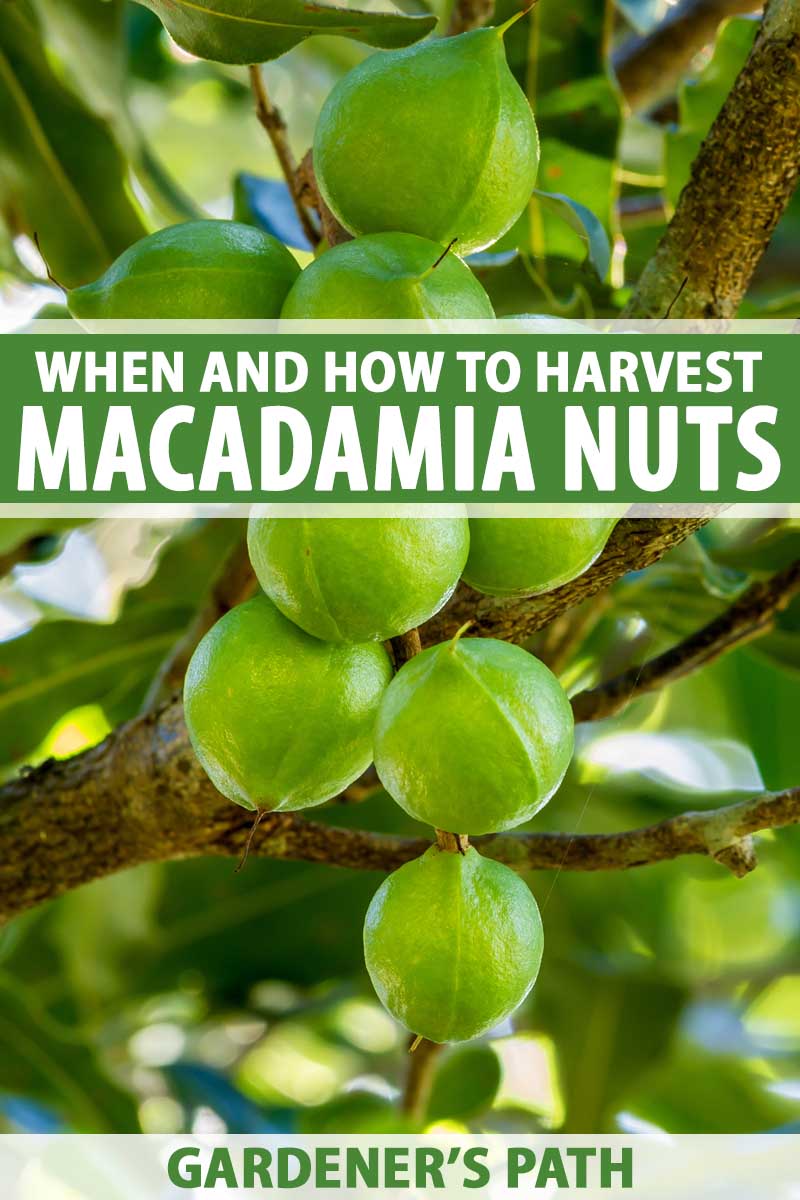
We link to vendors to help you find relevant products. If you buy from one of our links, we may earn a commission.
In this guide, we focus on harvesting. You will learn when nuts ripen, what they look like, and how to gather your crop. Here’s what’s to come:
What You Will Learn
Let’s get started!
Forbearance and Fruit Formation
Macadamia cultivation generally begins with a vegetatively propagated plant from a reputable nursery.
The average cultivar lives from 40 to 60 years. It begins to set fruit at six or seven years old. By the age of 10 or so, it reaches maturity and produces a 30- to 50- pound yield. Over the course of its life, the yield generally increases.
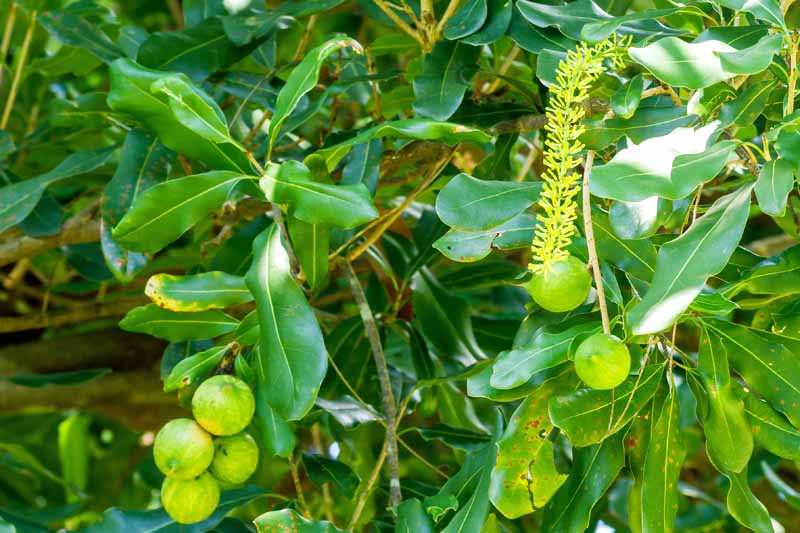
But prepare to be amazed, because some remarkable statistics have been documented. One tree in Coronado, California produced 270 pounds of nuts in one year, and another in Queensland, Australia is still alive at the ripe old age of 140.
That’s a long time, and a lot of nuts, so let’s find out when and how to harvest them all!
Signs that Signal Readiness
The fruiting season for macadamia begins in late autumn and continues through spring. The time to ripen varies by cultivar, but all varieties bear fruit continuously during their fruiting period, as opposed to all at once.
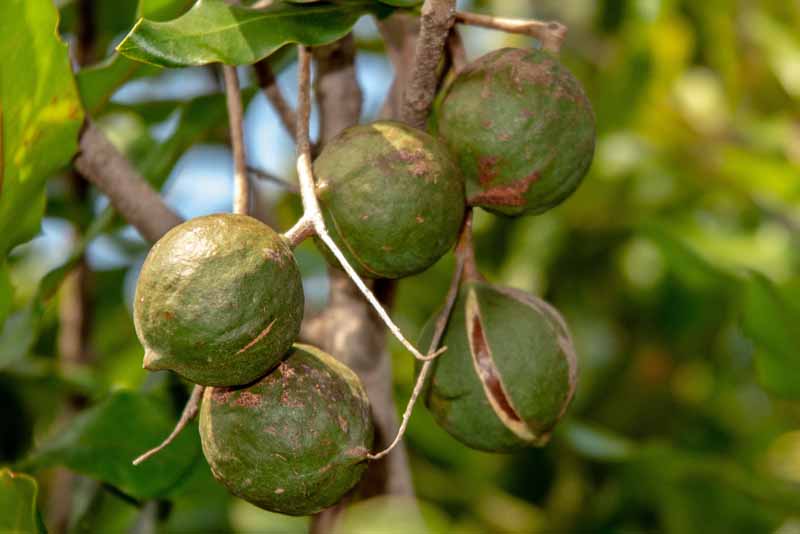
It’s not hard to tell when macadamias are ripe. Their husks begin to dry out, lose their tackiness, and gradually change from bright green to brown. They shrink and split open, their split edges turn brown, and the brown nut inside becomes visible.
There are varieties like ‘Cate,’ ‘James,’ and ‘Vista’ that “self-harvest,” and drop ripe fruit. This makes the job easy. Some people like to leave a tarp under them to collect their crop. I’m not a fan, as it may gather rainwater, rot your harvest, and damage the lawn below.
Instead, visit the tree or trees each day to reap what has dropped. Be sure to remove all fallen fruit, to keep hungry rodents away. Once gathered, remove the husks. Evaluate the shells within, and discard any that look moldy or damaged.
You may be tempted to shake the tree to loosen nuts, but don’t. Macadamia branches are on the brittle side, and you may injure them. In addition, unripe nuts may fall.
For cultivars that don’t drop fruit, you’ll need to judge their readiness.
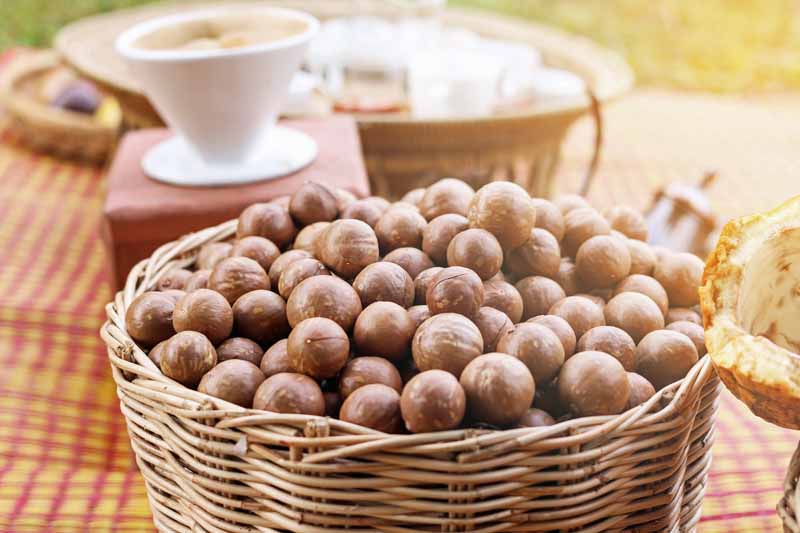
If they appear as described, place a tarp temporarily beneath the tree. Use a long pole to gently tap the branches (no shaking) and release ripe nuts. Some branches may bear a single fruit, while others may hold multiples in clusters.
When you’re through, put the tarp away for next time.
You could use a fruit-picking tool with a basket on the end, but I don’t recommend it. You may inadvertently catch it on unripe fruit, causing it to fall.
Reaping the Rewards
When a beautiful tree like the macadamia produces an abundance of nuts, it’s truly a sight to behold – and a mess to clean up!
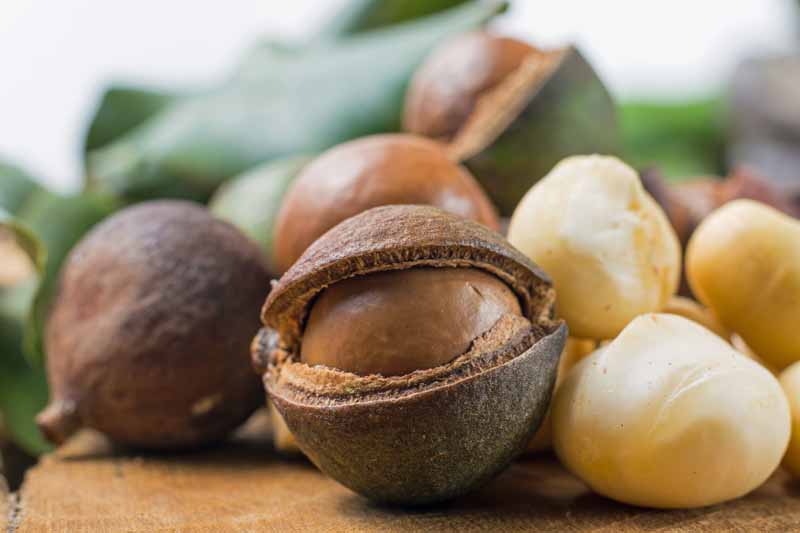
Take the bending out of gathering your harvest with useful tools, such as the Garden Weasel Large Nut Gatherer. Simply roll it along to gather your crop and slide the wire cage spreader to release it.

Garden Weasel Large Nut Gatherer
The handle is carbon steel welded with a comfort hand grip, and the wire cage is made of tempered steel. A lifetime warranty is included. You can buy this product now on Amazon.
Or, go all out with Bag-A-Nut’s 18-inch Push Harvester. Sweep your crop up as you push, collecting it in a removable basket.

18″ Push Sweet Gum Balls, English Walnut and Macadamia Harvester
It’s made in the USA and manufactured using 30% pre-consumer recycled plastic. You can find this product on Amazon.
Gather your harvest often, especially in damp weather, so it doesn’t rot or attract rodents.
Each time you collect a fresh batch, remove the husks immediately. Place the brown-shell nuts on wire racks in a cool, dry place to dry out for two to three weeks. As they dry, the nutmeats, or kernels, shrink away from the shell, and will come out easily when cracked.
Macadamia shells are very hard to crack, so be prepared to do the job with a hammer or vise. Use kernels immediately, store, or freeze.
Making the Most of Macadamia
Knowing when and how to harvest will go a long way toward optimal results.
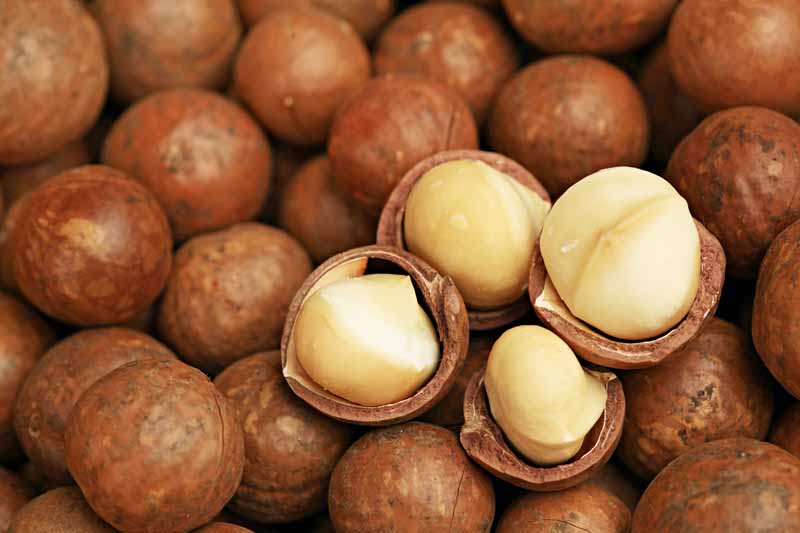
To recap, macadamias are ready to harvest when:
- They reach about 1 inch in diameter.
- Green husks begin to turn brown, shrink, and split.
- Split husks show brown edges.
- Brown shells are visible inside split husks.
- Husks feel dry to the touch, not tacky.
- “Self-harvesting” fruit begins to fall to the ground.
And remember to:
- Harvest often.
- Pick up promptly.
- Remove husks immediately after harvest.
- Dry kernels in-shell for two to three weeks before using, storing, or freezing.
- Discard husks or shells that look moldy, damaged, or unripe.
A macadamia tree isn’t just another pretty face in the landscape. When it reaches maturity, it yields an abundance of sweet, creamy nuts that demand a king’s ransom on the market today.
If you’re in USDA Hardiness Zones 9 to 11, I truly envy you! I can only imagine being able to go out to the backyard to get fresh nuts for holiday baking.
Please read our previous article, “How to Grow and Care for a Macadamia Nut Tree,” for all you need to know about topics including growing, maintaining, cultivar selection, pests and disease, storage, and recipes. Then schedule a trip to your local nursery to choose a new edible addition to your property!
© Ask the Experts, LLC. ALL RIGHTS RESERVED. See our TOS for more details. Product photos via Garden Weasel and Bag-A-Nut. Uncredited photos: Shutterstock.
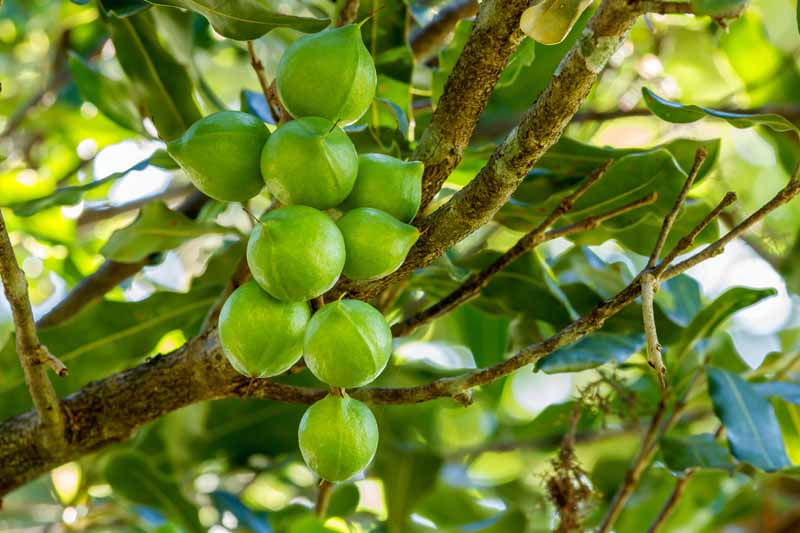
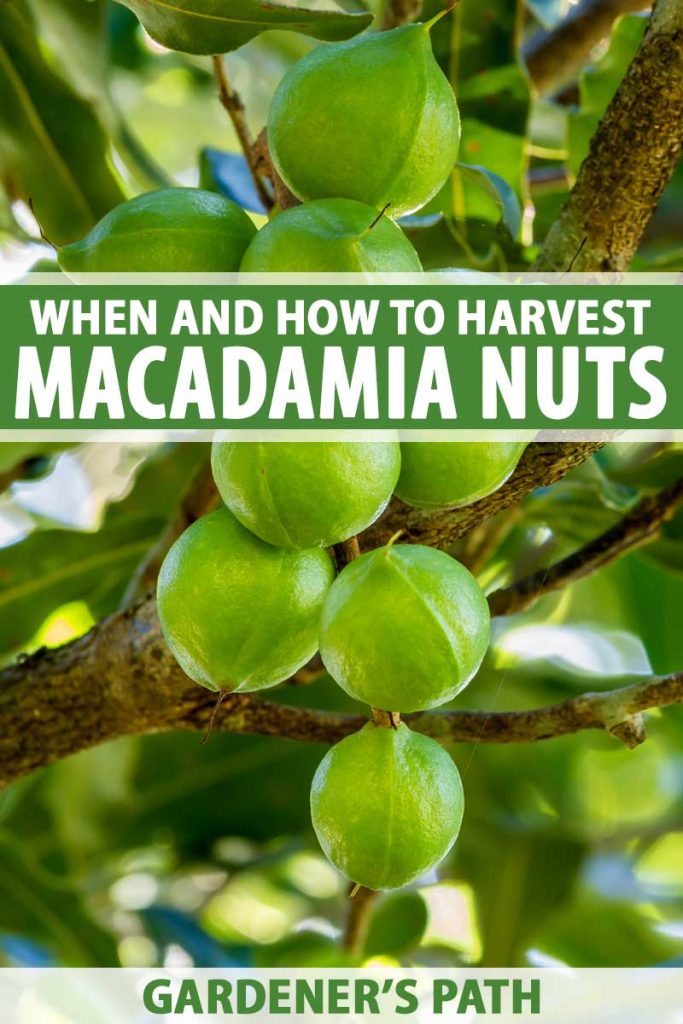
This is really helpful, was wondering why the ‘meat’ is stuck to the brown shell upon cracking open.
Hi Soph –
The fresher the macadamia, the higher the moisture content, and the more the kernel adheres to the shell. A few weeks of drying may make the nutmeat easier to extract.
Excellent writing, thank you!
An update: The old tree that was the first cultivated one still lives in our Brisbane city gardens. It is now 162 years old and bore nuts last season. The curator supplied nuts to Hawaiian traders who originally said the trees might make good windbreaks for the sugarcane crops. And so it began.
Happy to provide photos.
Wow, thanks for sharing this story, Frank! What an incredible piece of plant history! Please feel free to upload photos here.
Aged 162, its fruit isn’t very large nowadays, but still going. Of course the indigenous peoples would have been eating these for many tens of thousands of years, but this is the tree that supplied rest of the world, most notably Hawaii. The gardens were partly used to explore and experiment with new crops in the fledgling sub-tropical colony and was the source of many Queensland’s modern crops such as Macadamia, ginger and sugar cane.
Wow- thanks again for sharing, Frank!
Hi! I am in San Diego and my neighbor has a big tree. The tree, once laden with nuts, has been ravaged by the local squirrel population. It is the end of July and almost all the nuts are gone. The husks are still green but I think I have to harvest them now because there won’t be any left. Will they ripen off the tree? If I harvest them a little on the green side and keep them in the shells for a few weeks, will they be good to eat?
Hi Linda –
Macadamias mature on the tree, so harvesting them before they ripen may result in nuts that are inedible.
I have the same problem…I hardly ever get any nuts after they’ve been picked at by rats and other nut eating creatures! I’ve started to pick the green nuts still on their little branches, leave in the sun for a couple of days then the husk opens up…I peel that off and leave the nuts in the sun for about 2-3 days until they turn a nice golden brown colour. I then put them in a cool dry place for a couple of weeks to dry out and then they are perfect to eat. This year I managed to get… Read more »
Hello Angela –
Thank you for sharing your experience. Not everyone is able to tolerate unripe nuts without stomach discomfort, and ripening on the tree is advised.
Why is my Macadamia tree losing the nuts when very small?
Hi Nada –
We’re sorry to hear that the nuts are falling prematurely. Trees under stress may perform poorly. It sounds like the work of the macadamia nut borer or excessive rainfall earlier in the season. If the evidence points to the nut borer, pre-treatment next season may be advised. Please consult with your local agricultural extension for a firm diagnosis.
Hi! I was just given a bag of home grown macadamia nuts by a friend, and I cracked open (with a PVC pipe cutter) about 20 of them and ate them before someone else told me they had to be “processed” first. Am I at risk for anything, having eaten un-processed nuts? I can let them sit, I don’t know how long ago it was that they were harvested. Some popped out of the shells, but most had to be popped out with the edge of a knife. They all tasted good, softer and chewier than any I’ve had from… Read more »
Hi Susan –
Ripe nuts that are cured are easier to crack and better tasting than unripe or uncured nuts.
Eating unripe or green nuts may cause GI discomfort and is ill-advised, but not likely to be toxic in an otherwise healthy person without nut allergies.
When in doubt about the safety of foods, please consult your local board of health, poison control center, or local ER immediately.
Hi…my nut tree produces a lot of nuts but they aren’t all that big inside the shell once cracked…what am I doing wrong? the tree gets a lot of water and I put cow manure on 2 times a year.
Cockatoos Knock off all the macadamia nuts and they are soft and spongy inside. Can you eat them
Hi Jan –
Please do not consume any nuts that are soft and spongy inside.
What does the little hair indicate on the bottom of the green husk on the tree? Stages of ripeness? Ready to pick?
Hi Jim –
The small protrusion at the end of the macadamia nut is called a micropyle. It’s an opening for pollen and water, and does not indicate the stages of ripeness.
Our rodents are not shy of climbing the tree! One year recently, because I had not killed the rats, the tree had lost it’s whole crop before the nuts were ripe, because of rats and guava moth infestation.
Hi Helen –
Oh, dear! Herbivores and insects can indeed ruin a crop. Thank you for sharing the importance of keeping them in check.